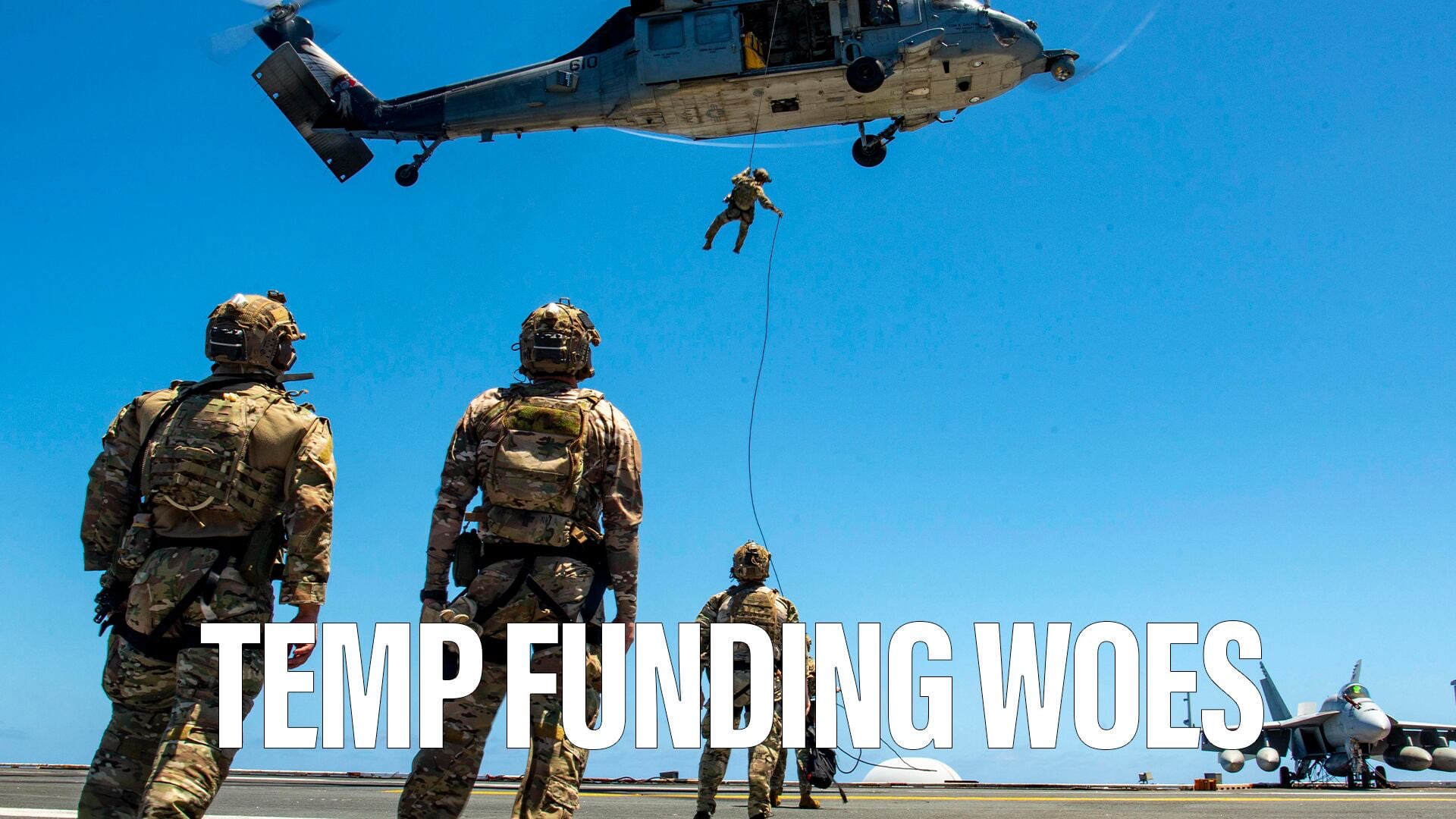FORT EUSTIS, Va. – Soldiers could have a new tool by next year that will measure their health, fitness and tactical readiness among a host of other performance indicators.
Progam manager George Matook and his team of researchers created Measuring and Advancing Soldier Tactical Readiness and Effectiveness, or MASTR-E, at the Army Combat Capabilities Development Command Soldier Center by joining wearable technology and servers full of data gathered over years of analysis and deep dives into past Army performance programs.
The outcome, Matook told an audience of nearly 800 officers and senior enlisted on April 26 at the annual Holistic Health and Fitness Symposium at Fort Eustis, Virginia, is a type of “performance dashboard” for soldiers, small units and, most importantly, their commanders.
“We’re tying this not just to health but to lethality,” Matook said.
Army Times has previously reported on MASTR-E, a five-year Army science program that concludes in 2024. The Army started the program as part of the larger Department of Defense Close Combat Lethality Task Force, which aims to improve how soldiers shoot, move, communicate, rest and recover in tactical training and on deployments.
It is the largest known defense department human performance science and technology program. The department has budgeted $100 million for the program, Matook said.
While debate continues over protecting soldier personal data when using wearable technology, Matook and others emphasized that the performance data would be aggregated for officials to review performance at the unit level. Meaning that commanders could see a snapshot of unit peforfmance from the individual to squad level and higher. Personal identifiers can be removed at the front end of that data collection.
In 2018 the defense department banned fitness-tracking devices for deployed troops over concerns that adversaries could access the geolocation and other data to learn more about the U.S. footprint and activities overseas, Military Times previously reported.
Two critical efforts in the program include creating quantified human performance measures and small unit performance forecasting.
This performance feedback has existed as part of how the military services manage things such as ships and tanks. But applying that framework to the performance of individual soldiers and small units required recent technological developments and a renewed emphasis on those troops and units.
The individual soldier wears a device such as commercially available smartwatch or fitness tracker. That data the flows into the commander’s “dashboard” view on a tablet or laptop.
A sample view of the “dashboard” that Matook showed has speedometer-like, color-coded gauges with needles running from dark red to dark green and shades in between. Red is bad. Green is good.
The simplified example shown to the audience gave big-picture physical and cognitive readiness scales and then a subset of the tactical outcomes with their own gauges.
While that’s helpful for soldiers, squads and even platoons or companies, even more information can be gleaned when the Army has outfitted multiple brigades and can mine the data to learn about performance trends across thousands of soldiers, Matook said.
Such data could influence types of rations to issue, soldier load and which units are called up to fight over others, depending on how rested and ready they are.
Much like the Army’s health program, the tactical readiness program analyzes four domains of predictors of performance and measures five areas of outcomes of that performance. Those areas are health, physical, social-emotional and cognitive.
The five outcomes include shooting, moving, sustaining, navigating and communicating.
Within each of the predictor domains and outcome categories are a host of factors and metrics that researchers analyze.
MASTR-E Predictors and Outcomes for soldier and small-unit performance:
PREDICTORS
- Health: immune system status, gut-microbiome, nutrition/metabolism, nutrition and eating habits, hearing/vision, sleep.
- Social-Emotional: lifestyle, motivation, resilience, personality, trait affect, spiritual, mindfulness, impulsivity, stress reactivity, emotional regulation.
- Physical: cardiorespiratory fitness, power and endurance, movement quality, body dimensions, flexibility, balance, strength, agility.
- Cognitive: attention, mental flexibility, decision making, spatial cognition, working memory, executive control, physical constructs.
OUTCOMES
- Shoot: shooting accuracy and precision, weapon stability, acquisition/engagement time, first fixation to target.
- Move: ruck march fatigue rate, ruck march recovery rate, other kill chain/virtual reality metrics, first fixation to target.
- Sustain: heart rate variability, cortisol after acute stress, survivability score, aerobic capacity.
- Navigate: time to objective, route efficiency, orienting, sector scanning.
- Communicate: shared vocabulary, voice onset times, noise/light hygiene, nonverbal communication.
Source: U.S. Army Combat Capabilities Development Command
In 2020, researchers took 530 soldiers from the 4th Battalion, 31st Infantry Regiment, and 2nd Brigade Combat Team, 10th Mountain Division and had them run through a field exercise measuring training load, physical exertion, sleep and recovery, Army Times previously reported.
Since then, Matook’s research team has conducted various other events, some focused solely on marksmanship, while others were more comprehensive, and analyzed a variety of human performance factors.
Starting in 2022, the team conducted a pilot study with an Army Reserve unit and soldiers from the 82nd Airborne Division out of Fort Bragg, North Carolina and the 513th Military Intelligence Brigade at Fort Gordon, Georgia.
From that point until November 2023, the team gathered data, refined their processes and are now finalizing the “dashboard” product for release in fiscal year 2024, Matook said.
The 2nd Brigade, 82nd Airborne Divisions “Red Falcons” are providing the final feedback and selection process as the researchers build the tactical readiness application for collecting and examining performance data, Matook said.
As the health and fitness program came online with 28 fielded brigades between 2020 and 2023, researchers have made ongoing tweaks to the readiness application that will companion with the Army’s Holistic Health and Fitness (H2F) program.
Those include features such as meal builders, macronutrient target indicators, appointment scheduling for physical or mental health checks and a fitness builder portion for workouts, Matook said.
The idea, Matook and senior H2F program leaders said, is to keep the application device-agnostic.
The Army has issued wearable technology such as smart watches, smart rings and fitness trackers for limited research. But experts said in multiple sessions that soldiers often have their own devices and would prefer to use them.
Within the physical domain, for example, the tactical readiness program aims to automate Army Combat Fitness Test data to eliminate pen and paper recording, which adds to the data entry load for researchers and soldiers, Matook said.

The application will also feature movement competency and screening protocols as well as physical injury profile data to measure movement capability and substitution exercises or movement for injured soldiers.
The analysis portion of the MASTR-E project holds promise for deeper looks at how training is affected by sleep, nutrition and stress. The application would benchmark an individual soldier’s physical fitness test scores and measure exercise training against combat rigors and help soldiers off-cycle physical training by measuring stressors and rest.
“We need to know how to adjust (period of instruction),” Matook said.
For instance, if a unit got slammed by tasks on a field training exercise and few of its members got enough sleep to be performing at full capacity the next day, which brings up questions for commanders, he said.
“Do we need to do this 20-mile ruck or use this as our rest day?” Matook said.
Leaders hope MASTR-E combined with H2F will give commanders science-based feedback on how to answer that question.
Todd South has written about crime, courts, government and the military for multiple publications since 2004 and was named a 2014 Pulitzer finalist for a co-written project on witness intimidation. Todd is a Marine veteran of the Iraq War.







